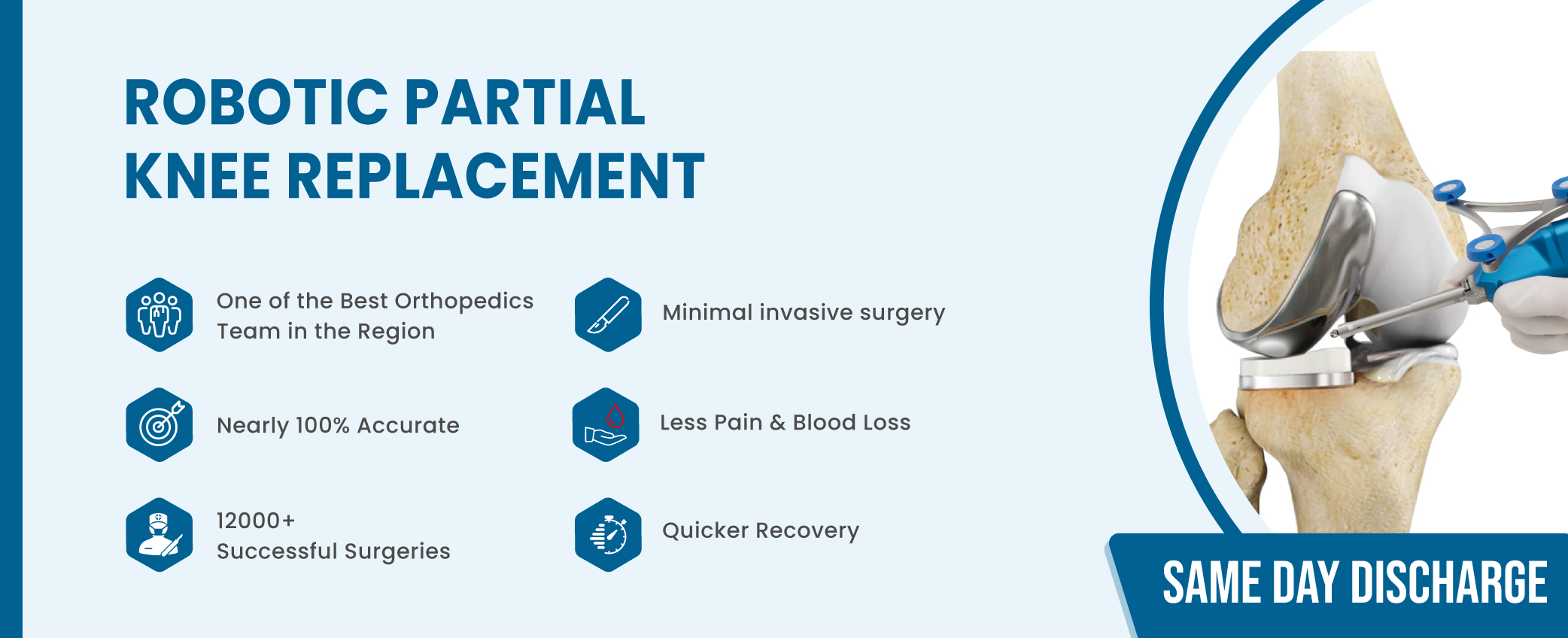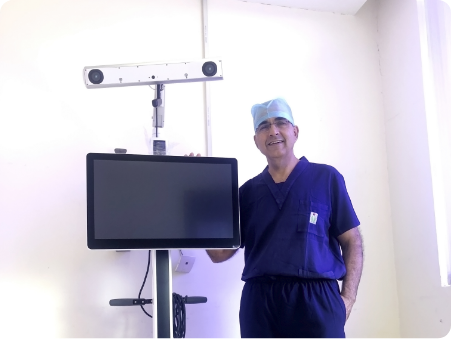Dr. Anoop Jhurani performed the first robotic-assisted partial knee replacement surgery
in Rajasthan in 2018.
Why should you choose Dr. Anoop Jhurani for partial knee replacement?
Dr. Jhurani, one of the partial knee replacement surgeons in Jaipur, and his team provide excellent partial knee replacement treatments. The expertise of our surgical team guarantees that there are no uncertainties regarding the precision and reliability of our surgical abilities.
When a patient chooses doctor Anoop Jhurani for partial knee replacement surgery, they will not only be comfortable, but they will also feel completely normal following the procedure. In most cases, they discharge patients the same day they undergo surgery, under the supervision of Dr. Jhurani.
Dr. Jhurani, who has performed over 12,000 knee and hip replacement surgeries and is a specialist in robotic partial knee replacement surgery and revision surgeries, claims that as a result, patient satisfaction has increased. The patient can resume everyday activities and feel normal once more. In order to provide his patients with the most satisfaction, he consults them to engage in aerobic exercises and other physical activities.

Benefits of a robotic partial knee replacement:
1. Robotic assist precise surgery
With a robotic-assisted partial knee implant, an orthopaedic surgeon can precisely target the damaged joint parts. The treatment leaves the healthy bone and tissue surrounding it unchanged; It resurfaced only the affected regions of the knee.
2. Faster recovery
Robotic surgery requires smaller incisions and disrupts surrounding tissues less than conventional replacement surgery, making it a less invasive procedure. Patients undergo less discomfort following treatment, and they recover more quickly; patients can resume regular activities earlier.
How long does it take to recover from a partial knee replacement?
Most patients recover from partial knee implants within 3 to 6 weeks, and they can resume regular activities within that time frame. Many patients discover that 6 to 10 weeks after completing physical therapy, they can resume their favourite sports.
Within days of the operation, they usually issue a cane to enable greater independence and start outpatient rehabilitation. After surgery, most patients can stop using their painkillers in 1 to 2 weeks.

How does a partial knee replacement work?
The knee joint’s damaged bone and tissue are removed during partial knee replacement surgery. The doctor performs the procedure if arthritis affects only a small portion of the knee. An artificial implant, often known as a prosthesis, is used to replace the missing tissue. Your knee’s remaining portion is unharmed. They typically use smaller incisions for partial knee replacements, which reduces recovery time.
For a robotic partial knee replacement in Jaipur, India, Dr. Anoop Jhurani is the only and best expert surgeon to meet with because he consistently completes this procedure flawlessly. He makes sure his patients are at ease and rapidly return to their regular lives. He uses robotic-handled arm technology, which reduces the possibility of error and provides nearly 100% accuracy throughout the operation. In Rajasthan, he pioneered robotic surgery and computer-aided surgery.
FAQ
What Type Of Knee Replacement Is Necessary?
Knee replacement surgery, also known as knee arthroplasty, is a surgical technique that replaces damaged surfaces of the knee joint in order to reduce pain and impairment and correct misalignment.
Knee replacement surgery in India is available as a partial or total replacement. Total knee replacement surgery is preferred when a patient’s osteoarthritis is multiple damaged and the joint is completely degenerated, but when a patient’s osteoarthritis is limited to just one part of the knee, unicompartmental knee replacement (also known as “partial” knee replacement) may be required.
The three principal compartments are the medial compartment (on the inside of the knee), the lateral compartment (on the outside of the knee), and the patellofemoral compartment (on the outside of the knee) (the front of the knee between the kneecap and thigh bone).
Only the afflicted area of the knee is replaced with metal and plastic in a partial knee replacement.
How Long Has Robotics Been Used To Replace Part of the Knee?
Manual joint replacement techniques are being phased out in favour of very precise and accurate robotic technology for knee replacements all around the world.
Dr. Anoop Jhurani, Director of Hip & Knee Replacement Services, Fortis Hospital, Jaipur, has launched the first robotic total knee joint replacements in Rajasthan and Central India.
Dr. Anoop Jhurani, who has experience performing over 12,000 Hip & Knee Replacements, has been serving Rajasthan’s patients for the last 15 years. Our center aims to give the best possible results of robotic partial knee replacement and robotic total knee replacement and offer the best robotic partial knee replacement and robotic total knee replacement in India.
What Is The Procedure For A Partial Knee Replacement?
Before the knee replacement operation, the patient’s anatomy is examined, allowing the implant to be customised to the patient’s unique anatomy. We then fit the leg with little metal pins, which act as “trackers” or “arrays,” telling the sensor where the leg is and when it moves.
After that, the patient’s bone structure and anatomy are examined. To guarantee that the joint is matched to the CT image, a set of positions is defined.
The ligament tension is then assessed when the knee is placed through a series of manoeuvres. The contact locations between the components are recorded and the mobility of the knee is observed.
This generates a graph of the knee and a 3D model of how it will function following the replacement. The surgeon can then determine and decide what the planned component point is in order to improve any area of the plan.
When the plan is completed, the model is shown to the team with the bone to be removed, stated in green. The surgeon then uses this to remove the bone, but the robot arm prevents the arm from moving outside of the plan, ensuring that the treatment is extremely precise.






